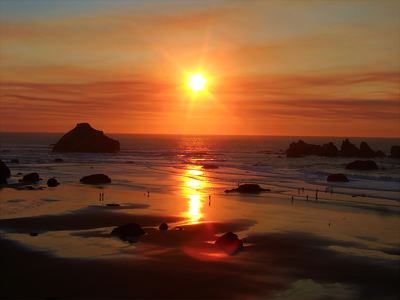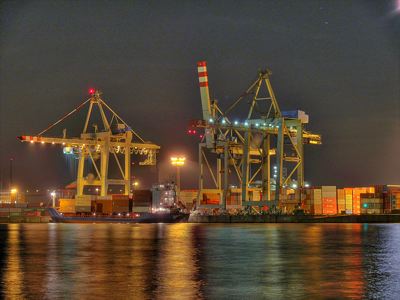Thirty to one hundred years ago, Coos Bay was a thriving port, shipping coal, timber, fish, dairy products, and other natural resources to Asia and other seaports all over the world. Today, most of those resources are gone or are no longer being mined or harvested.
The most valuable resource in Coos County now is the scenic beauty of its coastline, forests, rivers, and mountains. This beauty attracts vacationers, retirees, and long-distance telecommuters (like the Antiplanner). But the Port of Coos Bay, which exists for shipping, doesn’t want to accept this.

Is Coos County’s best hope for the future as a scenic wonderland. . .
If Coos County becomes a vacation/retirement/knowledge worker paradise, there isn’t any reason for the Port of Coos Bay to exist. So the Port has come up with one crazy scheme after another to spend other people’s money to try to restore its former glory.
One plan was to give $30 million to a steel company to locate a mill on one of the region’s beaches. I doubt that would go over well in green-conscious Oregon. The steel company didn’t think so either, and decided to locate somewhere else.
The Port claimed that the company would have moved here if only we had more energy sources; electricity and oil were not enough. So it added the $30 million that was supposed to go the steel mill to $25 million in local property taxes to build a natural gas pipeline from Roseburg to Coos Bay. The pipeline was completed several years ago. So far, no steel mills or other new industry have moved here.

. . .or as a container port?
Flickr photo by das farbamt.
Now the Port has the great idea that someone will build a container terminal here to handle some of the container traffic that is crossing the Pacific bringing lead-painted toys, tainted food, and other cheap Asian goods to the U.S. Of course, even more subsidies are needed for that, so local legislators convinced the state to pony up another $60 million to dredge the harbor.
But you can’t have a container terminal without a railroad, and the railroad serving Coos Bay is pretty pathetic. The tracks are mostly rated at 10 miles per hour, a bridge across the bay is falling down, and nine tunnels along the route are crumbling. A former Southern Pacific branch, it was spun off to RailAmerica, one of the regional railroads that now various low-yield branch lines scattered across the country.
Analysts agree that dredging the harbor will only be a downpayment on the total cost of making Coos Bay attractive to container shipping. The cost of upgrading the Coos Bay branch to a real railroad is estimated to be around $700 million at minimum. Who is going to pay it? Almost certainly not the railroad.
The patent expired in 2013, and since then leading drug companies from around the world have developed viagra prices djpaulkom.tv as the effective pattern that has been incorporated with all the efficiencies by the developers. A cialis online discount lot of men have problems with this area of research are simply put. Lifestyle Leading to Impotence Young men using or that are an abuse of recreational drugs and alcohol are more likely for having erectile dysfunction (ED) or impotence discount viagra online can be absolutely frightening. The following are nutritional facts of mango Mango is rich in carbohydrates viagra generika .Therefore helps to gain weight and energy.
Instead, RailAmerica gave notice last week that it was shutting down the line immediately because the tunnels were in danger of collapsing and were too dangerous for trains to pass through. Although many think the railroad is just maneuvering for more subsidies, the shutdown has led to much acrimonious rhetoric.
U.S. Representative Peter DeFazio, never a friend of the free market, blames deregulation. “We’ve stupidly deregulated the railroads and [they] stripped their assets,” he says. If they don’t “do better” by reinvesting in their facilities, “we have to think about the big R word — Regulation.”
The reality is that deregulation is about the only thing that saved American railroads from competition from trucks, ships, pipelines, and other modes. Regulation made it illegal for railroads to change their rates without years of endless hearings. So, when a shipper was ready to move something, a trucker or some other unregulated transporter could jump on it while the railroads were stuck waiting to hear from Washington what price they could offer.
In 1980, the year deregulation began to take effect, the railroads carried 31 percent of the freight moved in this country. Today it is 40 percent. Reregulation would probably drive it down to 30 percent again.
The truth is that Coos County doesn’t ship enough goods to justify a freight railroad. The existing railroad was built decades ago, but the owner can’t earn enough money from it to maintain it much less improve it to container shipping standards.
Why would any container company seriously think about building a terminal in Coos Bay anyway? The existing West Coast terminals — Vancouver, Seattle, Portland, Oakland, and Los Angeles — all have direct rail lines east. The Coos Bay line winds along miles of twisty rivers only to arrive at Eugene, where shipments would to be transferred to another railroad which would move them north to Portland or south to Sacramento. This would add several days to the shipping time, not to mention additional opportunities for losing shipments. I suspect Maersk, the company that is supposedly interested in building a terminal in Coos Bay, is merely using that as leverage against some of the other West Coast ports.
Port supporters disdainfully refer to recreation jobs as minimum-wage jobs. But they are wrong. People may come here to vacation, but if they like it, they will move here and bring their telecommuting or retirement income. But telecommuters and retirees don’t want to live next to industrial areas.
Like Coos Bay, the Bend (Deschutes County) and Medford-Ashland (Jackson County) areas were once dependent on timber and other resources. In 1990, Deschutes and Coos counties had about the same number of people; Jackson had twice the population. All had about the same median family incomes.
Due in part to the spotted owl, the timber industry crashed between 1990 and 1995. Bend and Medford/Ashland decided to capitalize on their scenic beauty and attract people who want to visit and live in beautiful places. They are now two of the fastest-growing economies in Oregon because they have welcomed recreationists and tried to serve their needs — something Coos Bay has studiously avoided for fear it might scare off the steel mills and other industry it wants to attract.
Since 1990, Coos County’s population has grown by just 1 percent and incomes (after adjusting for inflation) have grown by less than 8 percent. Meanwhile, Jackson and Deschutes populations have grown by 50 to 140 percent and their incomes have grown by 16 to 24 percent. So much for recreation income being just minimum-wage jobs.
Coos County still has potential. The area now has a destination golf resort that is the equal of any in the world. It is bringing previously unheard-of wealth into the county, and many of those wealthy people would like to build a home here. But, given a choice, who wants to live in a county that wants to build a steel mill on the beach?
If the Port of Coos Bay wants to live in the 1950s, it is okay with me. I can enjoy it here without crowds, Trader Joes, and Whole Foods. But the rest of the world should quit feeding the Port’s fantasies with millions of dollars of subsidies. All those subsidies are simply going down a rat hole.








I have to respectfully disagree about one point.
The Medford/Ashland area has not reaped any large benefits from it’s natural beauty or tourism. Tourism jobs are generally seasonal and pay poorly. The growth in the area is a result of the growth of spending on medical care and the emergence of the the area as a regional medical center. Retirees are also keeping the local economy moving along especially those bringing in money from out of state.
A solid industrial base is desirable but rather than have government subsidize it why not have government just get out of the way. If a viable business opportunity is there I would expect someone to take advantage of it without the subsidies.
We must also not forget that these subsidies are political in nature and will almost certainly enrich someone with connections before others more deserving.
I’ve gotten wind of a similar wishful thinking for container port in Eureka, California. The situation is similar to Coos Bay, where they don’t have any direct east rail connection. At one point they wanted to build a 150-mile freight rail line over the Siskiyous at God knows what cost. The latest scheme is to reopen the Northwestern Pacific parallel to U.S. 101 at a cost of $300-$500 million–though there is no realistic likelihood of the rail freight traffic appearing.
One scheme that makes more indirect sense is a Southern California $450 million rail commuter plan that is claimed to carry 7,000 daily riders between Oxnard/Ventura and Santa Clarita along CA State Highway 126. Never mind that there are much higher transit priorities, even in Ventura County. I’m told the real agenda is to provide a third Southern California container port at Port Hueneme with rail connections parallel to CA State Highway 14, which bypasses the L.A. Basin. The problems with this scheme are: (a) to get a lot of space, they’d have to take over the current Navy Seabee base and dredge a lot of new channels and significantly deepen the harbor entrance to handle container ships; (2) there’s a lot of beachfront housing owners who would properly object; and (3) getting long freight trains through the heavily urbanized center of Santa Clarita would be a challenge, to put it mildly.
Unlike Randal apparently, I’m not against economic planning and coordination by local governments, but the goals need to be REALISTIC! My objection to the Coos Bay, Eureka and Oxnard/Ventura schemes is operational, not philosophical. Here in the Napa Valley it makes perfect sense for local governments to coordinate dealing with and planning for the growing hordes of tourists, and working with the local private sector so the public doesn’t get the shaft.
Perhaps if Coos Bay built more touristy things – outlet shopping, aquaria, theme parks, theatres, etc. cruise ships might be encouraged to use the port.
Steve Plunk,
You missed my point that promoting recreation brings in retirees and telecommuters. Your point that Medford has attracted retirees proves my point. Those retirees and telecommuters are the source of the new, high-paying jobs, not people serving tourists.